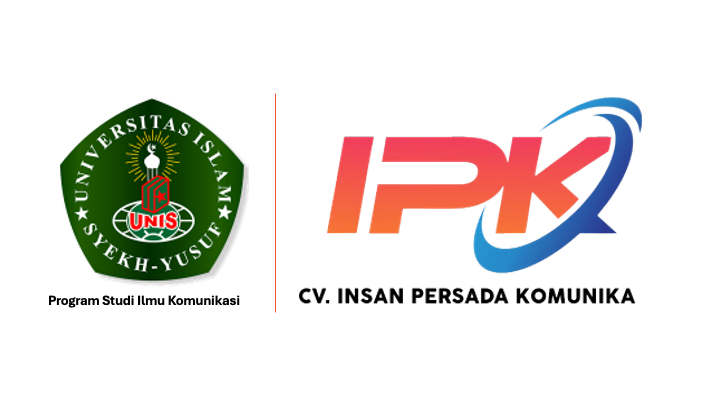PENGARUH MOTIF TERHADAP KEPUASAN MENONTON KONTEN INSTAGRAM @TVONEAI BERBASIS KECERDASAN BUATAN (AI) PADA PRESENTER BERITA
Keywords:
Artificial Intelligence, Motives, Satisfaction, Instagram, Uses and GratificationsAbstract
The development of Artificial Intelligence (AI) technology has brought significant transformation to the media and journalism industries, one of which is the emergence of AI-based news presenters now utilized by various digital platforms, including the Instagram account @tvoneai. This study aims to examine the influence of motives on satisfaction in watching AI-based news content on the mentioned account. A descriptive quantitative approach was employed, using a survey method and purposive sampling technique. A total of 117 active students from the Communication Studies Program at Universitas Islam Syekh Yusuf Tangerang participated as respondents. Data were collected through an online questionnaire measured using a Likert scale and analyzed using simple linear regression, including the coefficient of determination (R²) test and t-test. The results indicate that motives have a significant influence on satisfaction in watching AI-based news content on Instagram @tvoneai. These findings support the Uses and Gratifications theory, which states that media satisfaction is influenced by individual motives in using media, such as seeking information, entertainment, social interaction, and personal needs fulfillment.
Downloads
References
Ahadi, G. D., & Zain, N. N. L. E. (2023). Pemeriksaan Uji Kenormalan dengan Kolmogorov-Smirnov, Anderson-Darling dan Shapiro-Wilk. EIGEN MATHEMATICS JOURNAL, 11–19. https://doi.org/10.29303/emj.v6i1.131
Ainul Yaqin, A. M., & Islam Jember, U. (n.d.). Mediamorfosis K-Radio Jember di Era New Media. https://journal.uc.ac.id/index.php/calathu/article/vi
Aldausari, N., Sowmya, A., Marcus, N., & Mohammadi, G. (n.d.). Video Generative Adversarial Networks: A Review.
Azis, A. A. (2022). TRANSFORMASI PRAKTIK RUANG REDAKSI MEDIA ALKHAIRAAT ONLINE PALU (Vol. 9, Issue 1).
Binns, R., Van Kleek, M., Veale, M., Lyngs, U., Zhao, J., & Shadbolt, N. (2018). “It’s reducing a human being to a percentage”; perceptions of justice in algorithmic decisions. Conference on Human Factors in Computing Systems - Proceedings, 2018-April. https://doi.org/10.1145/3173574.3173951
Hasanah, D. S. (2023). PENGGUNAAN KECERDASAN BUATAN ( AI ) DALAM PEMASARAN ( Studi Deskriptif : Interaksi Konsumen dan Etika ) Dewi Syifa Hasanah. Urnal Terapan, Komunikasi Hasanah, 01(02).
Iqbal, T., & Qureshi, S. (2022). The survey: Text generation models in deep learning. In Journal of King Saud University - Computer and Information Sciences (Vol. 34, Issue 6, pp. 2515–2528). King Saud bin Abdulaziz University. https://doi.org/10.1016/j.jksuci.2020.04.001
Karelina, R., & Nurfebiaraning, S. (2020). Pengaruh Motif Terhadap Kepuasan Followers Akun Instagram @ Smbtelkom. Jurnal Komunikasi Dan Kajian Media, 4(2), 131–141.
Kong, J., Kim, J., & Bae, J. (2020). HiFi-GAN: Generative Adversarial Networks for Efficient and High Fidelity Speech Synthesis. http://arxiv.org/abs/2010.05646
Kumalarani, A. S., Hudaya, C., & Hartono, R. (2024). Analisis Pengaruh Penggunaan Presenter Kecerdasan Buatan (Artificial Intelligence) Dalam Penyiaran Terhadap Persepsi Audiens (Studi Kasus Di Tvone). Seminar Nasional Manajemen Inovasi, 7, 276–286.
Lenaini, I. (2021). Teknik Pengambilan Sampel Purposive Dan Snowball Sampling. HISTORIS: Jurnal Kajian, Penelitian & Pengembangan Pendidikan Sejarah, 6(1), 33–39.
Najmi, T., Sifara, C., Putri, W. E., & Pembayun, J. G. (2024). Pengaruh Penggunaan Akun Alter Instagram Terhadap Kepuasan Hidup Generasi Z. 4, 6440–6450.
Natasya, R. D. (2023). Implementasi Artificial Intelligence ( Ai ) Dalam Teknologi Modern. Jurnal Komputer Dan Teknologi Sains (KOMTEKS), 2(1), 22–24.
Ningrum, R. K., & Prihantoro, E. (2020). PENGARUH INTENSITAS DAN MOTIF PENGGUNAAN MEDIA INSTAGRAM TERHADAP KEPUASAN MENDAPATKAN INFORMASI FOLLOWERS AKUN @soloinfo. Jurnal Riset Mahasiswa Dakwah Dan Komunikasi, 2(2), 60. https://doi.org/10.24014/jrmdk.v2i3.10320
Norhusin, D., Panuju, R., Abror, D., Farni, N., & Maella, S. (2024). Peran Kecerdasan Buatan ( AI ) Dalam Ru6nitas Media Online Publikasi AI TvOne. 5(2), 8702–8712.
Nugroho, A., & Syas, D. M. (n.d.). MEDIAMORFOSIS TV ONE PADA ERA MEDIA BARU.
Nuraini, R. (2024). Respon Khalayak pada Penerapan Artificial Intelligence dalam Industri Komunikasi: Studi Kasus Presenter Buatan oleh tvOne. JCommsci - Journal Of Media and Communication Science, 7(1), 34–48. https://doi.org/10.29303/jcommsci.v7i1.258
Nurfiana, E. (2024). Artificial Intelligence: Analisis Praktik Robotic Journalism dalam Produksi Berita. Komunikasiana: Journal of Communication Studies, 6(1), 85. https://doi.org/10.24014/kjcs.v6i1.30723
Nurhakim, H. (2024). Daya Tarik Presenter AI dan Kepuasan Followers Terhadap Berita A di Instagram TVONE . AI. 3(2).
Ridwan, M., AM, S., Ulum, B., & Muhammad, F. (2021). Pentingnya Penerapan Literature Review pada Penelitian Ilmiah. Jurnal Masohi, 2(1), 42. https://doi.org/10.36339/jmas.v2i1.427
Rohmah, N. N. (2020). Media sosial sebagai media alternatif manfaat dan pemuas kebutuhan informasi masa pandemik global covid 19 (kajian analisis teori uses and gratification). Urnal Komunikasi Dan Penyiaran Islam.
Saidah, I. (2024). Model Industri Bisnis Media Massa Pada Era Perkembangan Artificial Intelligence (Ai) Di Indonesia. Linimasa : Jurnal Ilmu Komunikasi, 4(1), 44–59. https://doi.org/10.23969/linimasa.v4i1.3461
Salsabila, D., Yudhapramesti, P., & Bakry, G. N. (2023). Motif Khalayak dalam Mengakses Konten Berita di Instagram Reels @narasinewsroom. Jurnal Komunikasi Global, 12(1), 168–189. https://doi.org/10.24815/jkg.v12i1.30390
Saputra, A. (2019). Survei Penggunaan Media Sosial Di Kalangan Mahasiswa Kota Padang Menggunakan Teori Uses and Gratifications. Baca: Jurnal Dokumentasi Dan Informasi, 40(2), 207. https://doi.org/10.14203/j.baca.v40i2.476
Sukendro, G. G., Yoedtadi, M. G., & Pandrianto, N. (2024). Kecerdasan buatan dalam evolusi media dan komunikasi. Gramedia Pustaka Umum.
Sulistyawati Handayani, D., Kaunang, R., Sondang, S., & Irwansyah, I. (2024). Manfaat dan Potensi Masalah Penggunaan Kecerdasan Buatan (AI) dalam Komunikasi Publik. Co-Value Jurnal Ekonomi Koperasi Dan Kewirausahaan, 14(12). https://doi.org/10.59188/covalue.v14i12.4334
Sundar, S. S. (2008). The MAIN model: A heuristic approach to understanding technology effects on credibility. Digital Media, Youth, and Credibility, 73–100. https://doi.org/10.1162/dmal.9780262562324.073
Syahputri, A. Z., Fallenia, F. Della, & Syafitri, R. (2023). Kerangka berfikir penelitian kuantitatif. Tarbiyah: Jurnal Ilmu Pendidikan Dan Pengajaran, 2(1), 160–166.
Tambunan, N. (2018). Pengaruh Komunikasi Massa Terhadap Audiens. JURNAL SIMBOLIKA: Research and Learning in Communication Study, 4(1), 24. https://doi.org/10.31289/simbollika.v4i1.1475
Thifal Prameswari Tuffahati, S. P. J. F. A. K. D. D. (2024). Motif_Penggunaan_Twitter_Ohmybeautybank_Terhadap_P. Journal Of Comprehensive Sciene.
Utoyo, A. W., & Putranto, A. (2022). Praktik Jurnalisme Robot Sebagai Akhir Profesi Jurnalis. Jurnal Mahardika Adiwidia, 1(2), 86–99. https://doi.org/10.36441/mahardikaadiwidi.v1i2.1078
Yollanda, F. (2024). Tren Penggunaan Kecerdasan Buatan (AI) dalam Meningkatkan Pembelajaran Mahasiswa : Kajian Litaratur. SINTAMA:Jurnal Sistem Informasi, Akuntansi Dan Manajemen, 4(2), 226–234
Downloads
Published
Issue
Section
License
Copyright (c) 2025 Nebilah Nebilah, Ajeng Pradesti (Author)

This work is licensed under a Creative Commons Attribution-ShareAlike 4.0 International License.













